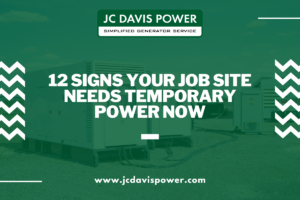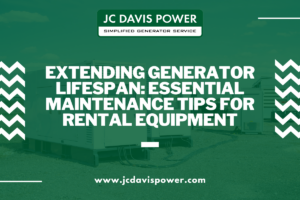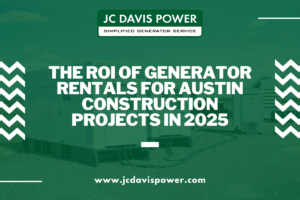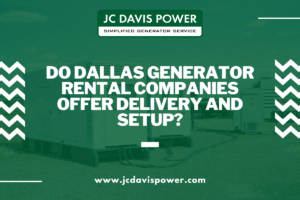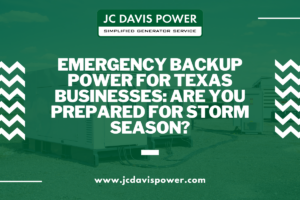Key Takeaways
- Ignoring early warning signs of inadequate job site power can lead to project delays, safety hazards, and unexpected costs.
- Proactive power planning – including assessing energy needs and leveraging mobile power solutions – is essential for modern construction sites.
- Investing in the right generator rental or backup system pays off in better productivity, compliance, and reputation.
Ever had your crew standing around, twiddling their thumbs, because the lights went out or a crane stopped mid-lift? Frustrating, right? Job sites are more vulnerable to power hiccups than you might think – and with outages on the rise, waiting until the grid lets you down isn’t just risky; it could cost you big time.
Did you know that, in 2020, U.S. electricity customers faced an average of just over eight hours of power interruptions—the worst since 2013 (EIA)? And those numbers keep climbing! Losing power today means more than a minor inconvenience; it puts your schedules, safety, and bottom line in jeopardy. Let’s dive into the signs your project can’t ignore—and how to get ahead of the next blackout.
The Hidden Risks of Power Outages on Job Sites
Understanding Job Site Power Vulnerabilities
Most construction projects rely on grid power. While it’s convenient, it isn’t always reliable—especially for remote job sites or projects on tight deadlines. Here’s a number that might surprise you: over 80% of power outages in the U.S. are tied to the local distribution system (WorldMetrics.org). If your build is at the end of the line or in a growing neighborhood, you could be at higher risk.
Construction energy needs only increase with site complexity, yet many contractors treat power as an afterthought until something goes wrong.
Key Triggers for Unexpected Power Failure
Why are outages becoming a fact of life? For starters, severe weather now causes about 50% of all power outages (ASCE), and weather-related outages have doubled since 2003 (JC Davis Power). Older infrastructure, equipment failures, and overloaded grids pile on the risks.
Having a contingency—like mobile power solutions—isn’t just nice to have; it’s now part of proactive job site readiness.
People Also Ask (PAA):
How do power outages affect job site productivity?
Outages bring work to a standstill, delay timelines, disrupt safety systems, and sometimes require costly overtime to recover.
The Growing Financial Impact of Power Interruptions
Quantifying Downtime and Losses
Let’s talk dollars and sense. Power outages cost the U.S. economy up to $150 billion annually (WorldMetrics.org)! Even a brief outage can cascade into days of lost productivity, missed deadlines, and contract penalties. Some estimates put the annual loss as high as $169 billion (JC Davis Power).
| Impact of Power Outages on Job Sites | Example Consequences |
|---|---|
| Project Delays | Missed handover dates |
| Overtime Costs | Inflated labor expenses |
| Equipment Downtime | Rental penalties |
| Lost Reputation | Fewer repeat clients |
For context: The average data center outage cost rose from $505,000 to $750,000 in just six years (ASCE). While your project might not be a data hub, similar logic applies—waiting too long to secure power gets pricier every year.
People Also Ask (PAA):
What is the cost of an unexpected power outage on a construction site?
Costs vary with scale and timeline, but downtime typically leads to extra labor, lost productivity, contractual penalties, and equipment risks.
Assessing Your Site: 12 Signs You Need Temporary Power Now
So, how do you know your build is at risk? Watch for these red flags, and act before the next “lights out” moment.
| Warning Sign | What it Means & What to Do |
|---|---|
| 1. Frequent outages/voltage dips | Site is too dependent on unstable grid. Consider generator rental. |
| 2. Remote or new site location | Delays in permanent connections? Choose mobile power solutions early. |
| 3. Critical ops at risk | If lifts, cranes, or surveillance need power 24/7, don’t take chances. |
| 4. High-profile deadlines | Even an 81-minute outage (WorldMetrics.org) could blow your schedule and budget. |
| 5. Site or scope expansion | Adding trailers, lighting, or equipment? Initial supply may not cut it. |
| 6. Storms or adverse weather due | Outages often strike hardest when you least expect them. Secure backup ASAP. |
| 7. Recent power failures | Past outages predict future risk—don’t assume it’s a one-off. |
| 8. Compliance or safety mandates | Some phases require backup systems or redundant power for legal reasons. |
| 9. Valuable assets/processes | Protect high-stakes gear or in-progress installs with uninterruptible power. |
| 10. Utility notifications | If your provider warns of possible outages or maintenance, plan for backup immediately. |
| 11. Need for after-hours lights | Security and night shifts run on clean, reliable power—don’t overlook them. |
| 12. Peak construction phases | Heavy equipment draws more power at once; be ready for surges and overloads. |
People Also Ask (PAA):
How can I tell if my job site power solution is inadequate?
Look for flickering lights, frequent resets, overloaded circuits, or delays due to electrical issues.
For more on what to expect from your generator provider, check out our Generator Rental Service Guide.
Choosing a Temporary Power Solution: What to Look For
Assessing Your Construction Energy Needs
Don’t just guess your wattage. List all tools, lights, trailers—then factor in expansion and safety margin.
What matters most?
- Scalability: Can your solution grow with site phases?
- Runtime: Does it last through rainy nights?
- Flexibility: Need to move it between projects or locations?
Types of Mobile Power Solutions
Not all generators are created equal. Options include:
- Portable generators (for tools, lights, and single trailers)
- Towable, large-capacity units (for site-wide backup)
- Parallel/rental banks (combine units for more power or redundancy)
- Hybrid or eco-friendly models (mix solar with diesel or gas for sustainability)
People Also Ask (PAA):
What types of mobile power solutions are best for construction?
Flexible, fuel-efficient, and easily scalable generators or hybrid systems are ideal for varied job site demands.
See our breakdown of mobile office power setups for more ideas.
Partnering with a Trusted Power Provider
Look for:
- Rapid response for emergencies
- Expert site assessment and recommendations
- Ongoing support (maintenance, refueling, 24/7 troubleshooting)
Consider working with a provider like JC Davis Power, where site-specific solutions are our bread and butter.
Avoiding Common Pitfalls: Maintenance, Safety & Compliance
Keeping Power Flowing—Safely
Temporary power isn’t “set it and forget it.” Schedule periodic maintenance, checks for safe grounding, and train site staff on basic troubleshooting.
- Real-time monitoring: Some modern rentals (with remote dashboards) alert you to problems before you’re caught off guard.
- Safety checks: Always verify cables, load balance, and proper PPE before switching or maintaining power.
Staying Compliant
Permitting, emissions standards, and noise regulations can catch you off guard. Work with a knowledgeable provider to ensure you meet all local, state, and EPA requirements (especially for Tier 4 emissions—see our explainer).
People Also Ask (PAA):
Do I need permits for a rental generator on my job site?
Often, yes—especially for extended or large-capacity units. Local codes may require filings for emissions, occupancy, or safety.
The ROI of Proactive Power Planning
Costs Saved vs. Costs Lost
Let’s boil it down:
| Scenario | Upfront Generator Rental | Unplanned Outage Losses |
|---|---|---|
| Day-to-day Project | Manageable, predictable | Spiral overtime, penalties |
| Critical Deadline | Budgeted, insurable | Potential multi-day delays |
The average American loses 6.8 hours/year to outages (WorldMetrics.org), but many job sites can lose far more per event.
Enhanced Productivity and Reputation
Minimizing power risks means fewer headaches for your team, smoother handoffs to stakeholders, and a stronger reputation with clients (who often prefer contractors with backup plans).
Action Steps: Getting Ahead of Power Problems
Create an On-Site Power Assessment Checklist
Use this starting point:
- Inventory all electrical equipment and needs.
- Audit recent outage frequency and caused delays.
- Factor in planned expansions or heavy-phase timelines.
- Monitor weather patterns in your area.
- Establish “trigger points”: when do you rent or upgrade backup?
Download a more detailed checklist from our Contact Us page or request a consultation.
Work with Power Solution Experts
The right partner can help with:
- Customized site power planning and installation
- Ongoing monitoring and regular maintenance visits
- Emergency response if conditions change overnight
Need a site-specific plan? Start with a call to JC Davis Power.
Don’t Wait for the Next Outage—Act Now
Power interruptions aren’t just a nuisance; they’re a growing threat to every construction project, big or small. Recognizing the early warning signs and investing in mobile power solutions beats scrambling after a costly blackout.
Worried your job site isn’t prepared? Don’t wait until the next hiccup stalls your project. Take five minutes today to assess your needs or contact us for a free site power audit. Protect your timelines, your budget, and your peace of mind.
FAQ
1. What is the difference between portable and towable generators for job sites?
Portable generators are compact and ideal for small-scale power needs or single tools. Towable generators provide higher power output, can support larger equipment, and are easily moved across a big site.
2. How do I calculate how much generator power I need?
Add up the wattage requirements for all devices running simultaneously. Include a buffer (usually 20-30%) for startup surges and potential expansion. Not sure? Use an online calculator or talk to your rental provider.
3. Are mobile power solutions noisy or environmentally harmful?
Modern generators—especially Tier 4 engines—are quieter and meet stricter emissions standards. Battery-hybrid models or solar-assisted setups can further reduce both noise and pollution.
4. Can temporary power systems run critical safety equipment?
Yes. With proper sizing and backup arrangements, mobile power supports lifts, security cameras, alarm systems, and lighting—ensuring continuous safety during outages.
5. How quickly can I set up temporary power after a failure?
Setup speed depends on site access and the provider’s inventory, but some companies (like JC Davis Power) offer rapid deployment, often within hours, to most metro or suburban locations.
